| | | 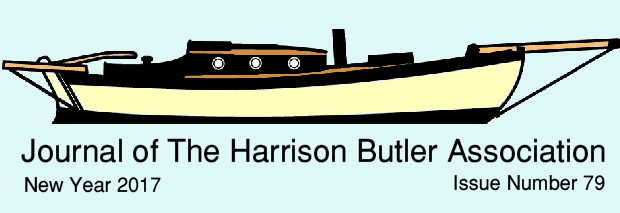
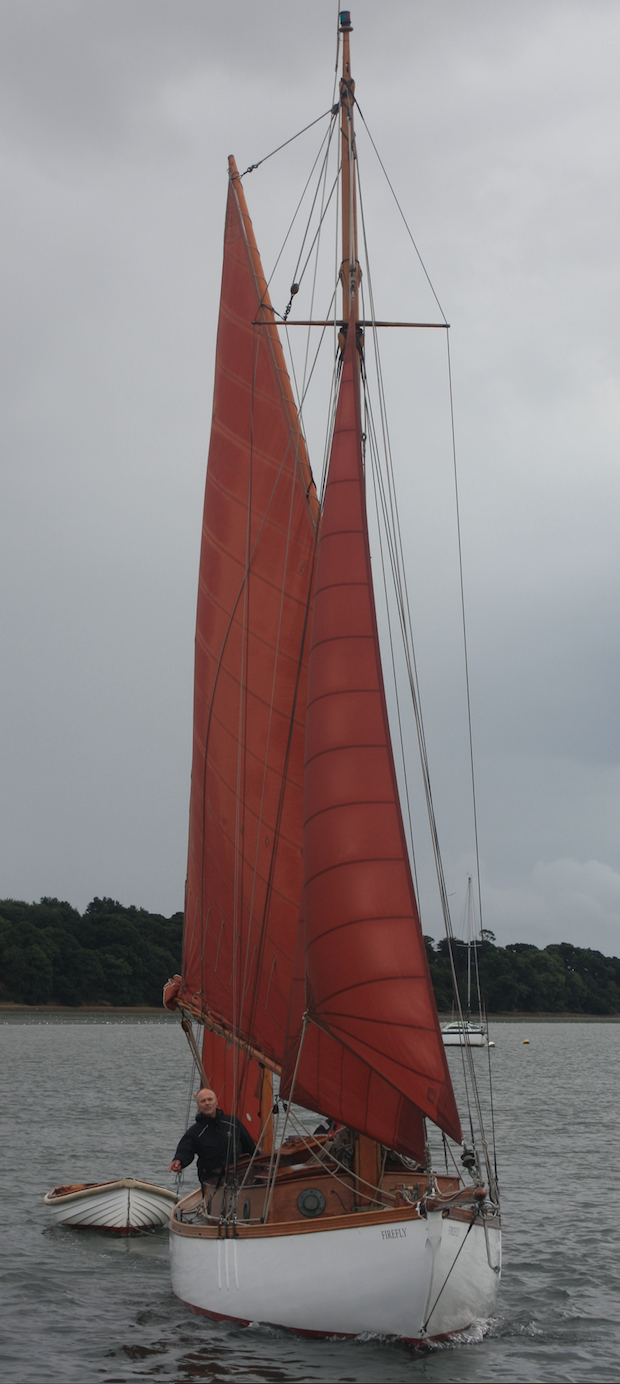
Firefly on the River Orwell, August 2016
Photograph by Martin Hansen
The Journal of The Harrison Butler Association
Editor : Martin Hansen
Proof Reading : Dr Helen Jones
Far East Correspondent : Dr Stephen Davies
Australian Correspondent : v a c a n t
Netherlands Correspondent : Michiel Scholtes
Baltic Correspondent : Myriam Spicka
UK Correspondent for The Solent : Robert Griffiths
UK Correspondent for Dartmouth : Allen Clarke
Contributions for the Journal are most welcome be they
fully formed articles, rough notes or snippets of News.
If you feel you would like to contribute on a regular basis,
applications to join our growing network
of correspondents are also invited.

I began 2017 by taking a Sunday walk with Zeta, my dog, along the beach. The interest was not the view out to sea but rather the massive construction site on the shoreline. Our stroll was along the sands at Rossall Point, Lancashire, where the UK's current biggest coastal flood defence project is nearing completion. This is a 2 km stretch of sea wall being built at a cost of £63 million. Considered essential to protect 4,500 nearby homes, the new build dwarfs the 1980s built previous defence, which it is replacing.
The impact of incoming storm waves are reduced in stages, which I've tried to capture in a single photograph. There is an initial barrier of rocks, each between 2 and 10 tons. Then a staircase of concrete steps is topped by a concave first wall, shaped to throw the water hitting it back out to sea. Behind is a wide catch zone and, finally, a second higher wall. The defence is claimed to have a 100 year design life and to be able to withstand a 1 in 200 year storm event. It is impressively massive; I don't think I've ever seen so much concrete all in one place.
With sea levels currently creeping up by 3 millimetres per year, and a more turbulent atmosphere considered likely, it's reassuring that the UK is developing the expertise that will be necessary to lessen the effects of living in a world where water, long locked away as polar ice, is steadily being released.

The £63 million Sea Wall under construction at Rossall Point, Fleetwood, Lancashire

!•¡•! Classic Boat has published and made available online HBA Chairman John-Henry's letter calling on all Classic Boat Associations to support his Boat Building and Maintaining initiative. It's taken a couple of years to get this project moving but it's finally gone live, and a source of pride that it's the HBA leading the way on this important matter.
!•¡•! The HBA's AGM for 2017 is on Saturday 11th February, once again at the Guildford Golf Club. The traditional pre-AGM meal is at 12.30 pm. Full details will be sent to members in due course along with the agenda.
!•¡•! The Harrison Butler designed boat, Seasalter, will be on display at the 2017 Australian Wooden Boat Festival, in a few days time. Seasalter has featured regularly in recent issues of the Journal and so this is an excellent opportunity for Members 'down under' to see this grand and fully restored HB thoroughbred and her skipper Jay Lawry.
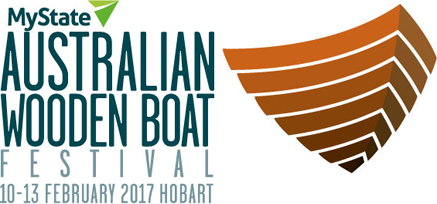
!•¡•! The HBA Year Book for 2017 has been published and distributed to all Members. In addition to the contact details of our 154 members, John-Henry Bowden reflects upon 2016 in his Chairman's Letter, and Paul & Jane Barns have penned a delightful article, exclusively for the Year Book, on the pleasure they are having sailing Mischief III. The Year Book is obtained by becoming a member.
!•¡•! Since the previous issue of the Journal was published, Amiri, Zingara, Thalamege and Spindle have sold. New on the market ready for the spring surge of interest are Mary Gray and Caracole, both reasonably priced.
!•¡•! Practical Boat Owner has published a five page article by Peter Poland on “Harrison Butler Boats” to widespread acclaim. The article is packed with a wide variety of photographs, quotations and is both accurate and informative about the joy of owning one of these very special boats. Craig Nutter's Sabrina is on the cover of the magazine; she is now well established as the HBA's “pin-up girl”.
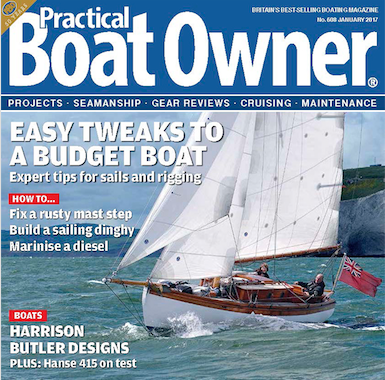
Blind Child
Michael Scholtes
The HBA's Netherlands Correspondent

Fog on Eenhoorn's horizon
In darkness Eenhoorn sailed slowly over the Wee Bankie off the Scottish East coast heading southwards with the Firth of Forth around 25 miles off to starboard. Every once in a while moonlight fell through a gap in the cloud cover to reveal a shimmering silver sea and the black triangle above the yacht was transformed into ghostly pale cloth, tensioned by gentle, steady wind. Everywhere the sea whispered and lisped. Sometimes, on the roll, reef points slapped against the mainsail. Down below, empty glasses toasted the silent night.
I, however, was not at peace. Below deck I studied the forecast again; strong winds and mist in Cromarty. Although the bad weather was well to the north, I was restless; the weather doesn't always respect the Met Office's zones and I could feel colder Scottish land air sweeping over the warmer water of the North Sea around me. I climbed up into the cockpit. I should have been able to pick out the strong beacons of St. Abbs in the west and Farn Islands to the south, but couldn't. Something was not right.
Suddenly I noticed the navigation lights of a motor vessel, alarmingly nearby. Once I'd ascertained we were not on a collision course, I switched my gaze to Eenhoorn's masthead tri-colour. It was engulfed in a greasy corona, of red, green and white - bad news. The lights of the motor vessel, clear and nearby minutes ago, had gone. My heart sank as I realised I was in thick, blinding fog. I listened intensely, my open hands behind my ears. If I heard a ship's engine, what would I do? Would I be able to determine its direction and movement? Of one thing I was sure; I was not the only ship out here and the others were mostly very, very much bigger than me. Should one of them plough into me, it was unlikely they would even notice. My imagination played cruel tricks on me that night: Several times I heard a brisk and steadily increasing hiss, and almost saw the killer engulfing bow wave, thundering towards Eenhoorn from the darkness. My head knew that the chances of being run down by another ship were slight for I was but a blip on the vast sea. But the reasoning did nothing to ease my fear. And, yes, I was afraid.
“All ships, all ships. This is sailing yacht Eenhoorn, 4 miles north of Farne Isles, stopped in fog. Request communication with ships in this area.”
Silence.
More silence, but then; “Sailing yacht calling. This is motor vessel Cambrian Enterprise. What is your name and position, please? Over”.
“Cambrian Enterprise, good morning. This is sailing yacht Eenhoorn. My position is 55° 43.6' North; 001° 37.7' West. Stopped. Bound for Newcastle. Over”.
“Eenhoorn, I can see you. I will pass ahead of you, steering 355°”.
A conversation unfolded. I as talking to an African first mate with a round and melodious accent. He was so worried about my predicament that he volunteered to be my ears and eyes. He reassured me that his radar indicated no traffic around and that I should steam at 4 knots southwest towards Skate Road, away from the coastal route around the Farne Isles. Half an hour later, I heard him communicate with a Scottish fisherman: does he know that there is a yacht to the east of him? I am touched by his concern; a caring, friendly foreigner looking after me, a blind child.
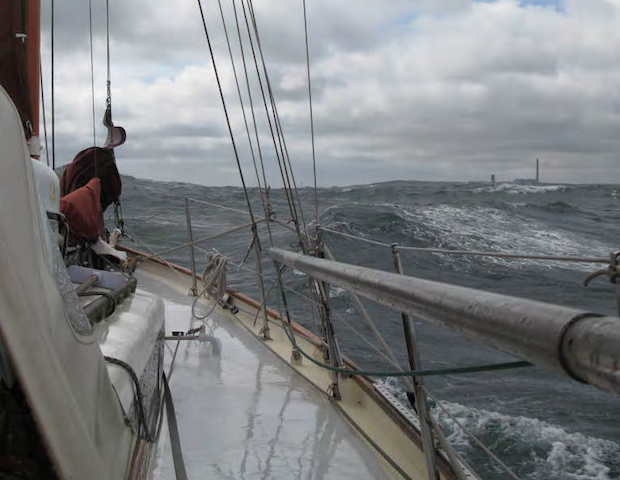
The wet and grey day on the
lumpy North Sea that chased Eenhoorn's night terrors away
The seabed rose from sixty to thirty metres and daylight seemed to chase both fog and night away. Islands appeared on the lumpy horizon of a grey sea. Then, from behind the distant receding fog-bank the sun appeared, shrouded at first, then ever more glorious; pink, orange and molten gold.
I set sail for the reef north of Longstone. By the time I had reached Crumbstone the sun was causing steam to rise from the warming deck. I listened for a fare well from the Cambrian Enterprise but the VHF stayed silent. I thanked her from my heart. Before I reached Alnmouth Bay the wind turned south and increased. I tacked towards the river Amble on a brilliant sea with countless white horses. To starboard lay the fields and cliffs of Northumbria. The air was so clear that I could count the stones in the walls of Castle Point ruins. Amidst the “it's good to be alive” day, I periodically studied the rig for the best place to install a radar dome.
Exploring The Danish South Sea
Myriam Spicka
The HBA's Baltic Correspondent
Endless white beaches, secluded lagoons, turquoise sea, open blue sky: not the Caribbean but rather the Island speckled sheltered waters of the Danish South Sea, just two days passage from Mowa's home port of Lübeck. These waters at the south-west end of the Baltic are a sheltered sailing paradise of little towns, sandy beaches and charming anchorages, so numerous few have visited them all.

Mowa approached this cruising ground with two stop-overs, the first at the marvellous harbour of Orth on the island of Fehmarn, the second in the entrance of the Haderslev Fjord. We were heading north-west through the Lillebælt, a strait between Denmark's third largest island, Fyn, and the eastern coast of the Danish mainland. A strong current resulted in an exceptional speed of seven knots over the ground, our delight at the swift progress enhanced further by an escort from a school of porpoises. At the town of Middelfart the Lillebælt bends and a day was spent exploring a wonderful anchorage here in Fænø Sound.
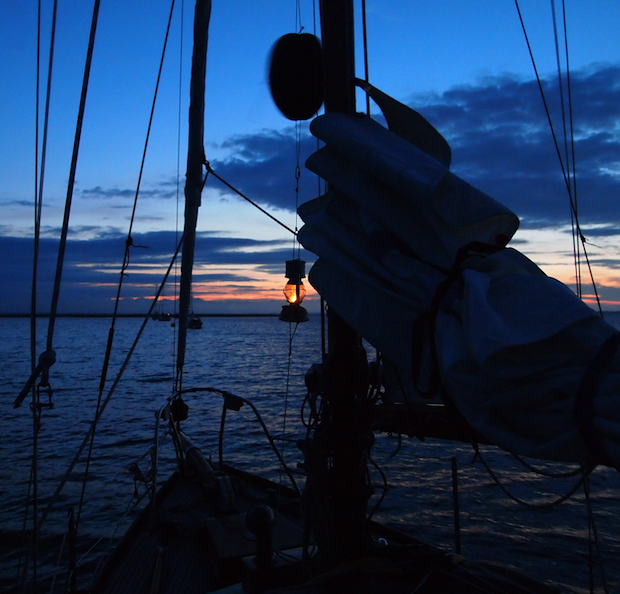
In the Danish South Sea progress does not just depend upon the tide; the wind too has a strong influence. Before modern internet based micro-weather forecasting, days could be lost tacking against wind and current at the northern end of the Lillebælt, in an area sailors refer to as “Tragten”, which translates as “funnel”. Judging the timings correctly, our exit was swift and Mowa raced towards the island of Endelave, the geographical centre of gravity of Denmark, west of Samsø. Here there was quietness, peace, pubs and a thriving harbour. A tiny local museum turned out to be very interesting, and a charming church had little models of sailing ships hanging from the ceiling.

In the Danish South Sea there are shoals, shallows and sandbanks. It's all too easy to run aground when an unexpected cross-wind spins a fast-moving boat through 45°. Part of the helmsman's job is to keep an eye abeam on the water surface for signs of such a cross-wind approaching.
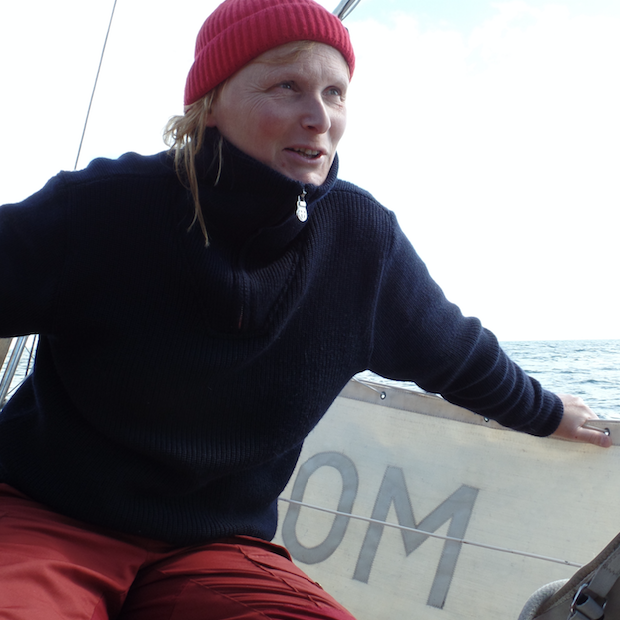
Mowa's next landfall was west of Århus, Ebeltoft - home of the ancient Fregatten Jylland, the longest wooden warship in the world. A weather forecast of two weeks of strong southwest wind made Sweden tempting, but the thought of fighting our way against it to get back home made us resist. Instead we explored the Mols Bjerge, a magnificent National park.
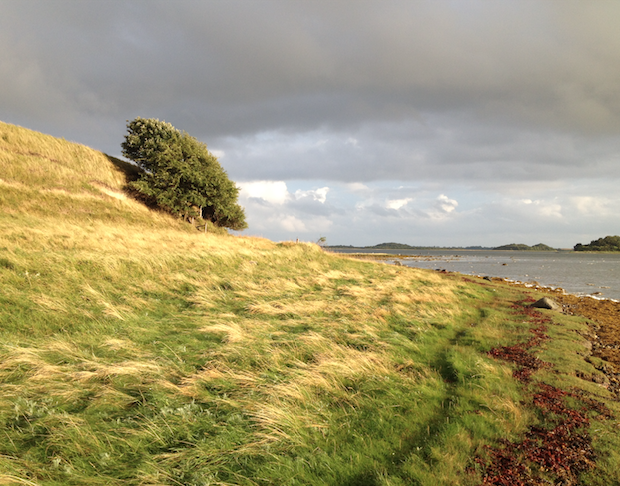
A blustery passage took Mowa the the Island of Samsø where we sat out bad weather, a lonesome church overlooking us at anchor in the Langør lagoon. A few days later we entered the perfect horseshoe bay at Knebel Vig, north of Århus. Here there was no ship but Mowa for the night. Few non-local sailors go further into Kalø Vig than the Power Station of Sudstrup, but beyond this we found an interesting, secluded sailing area. There is a marina at it's northern end, Nappedam, situated next to Kalø Slotsruin, the remains of a large 14th-century castle. With heavy mottled clouds blown by a blustery howling wind over the old tower, we felt we had fallen out of time. That night, rain hammered down on Mowa's deck while we had dinner, happy to be in the marina.
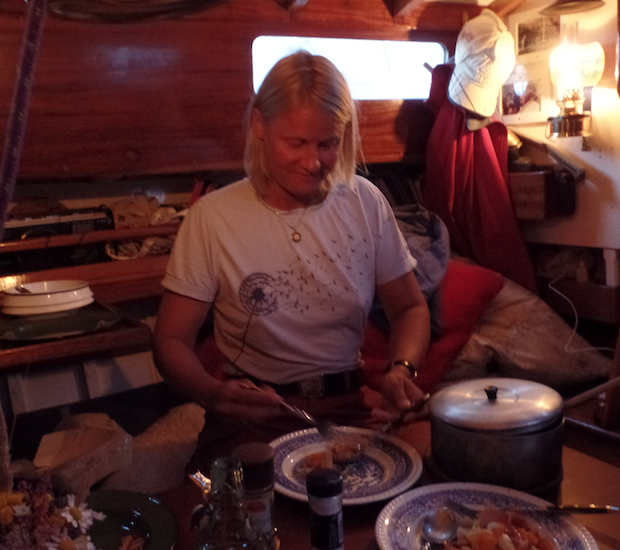
On our way back home we spend some days in Århus, the second biggest town in Denmark, in a nice and friendly traditional Ships harbour, enjoying little cafes, the new museum of contemporary arts and the atmosphere of a university city.
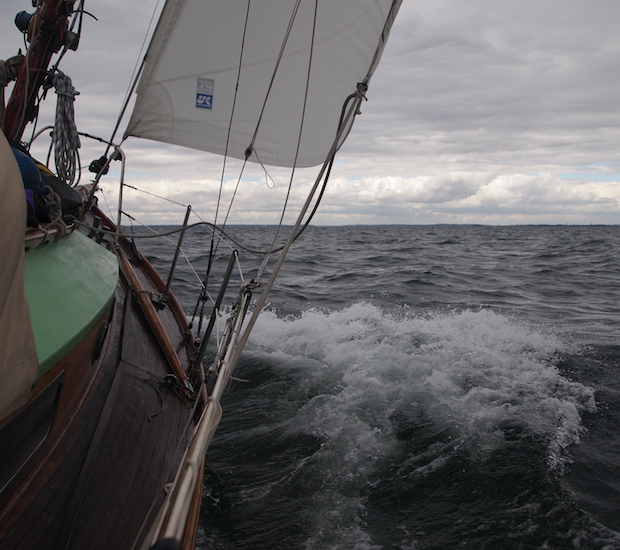
A hypnotic steady horizon on the passage home, over slate coloured seas, gave time to reflect upon how lucky we were to have had another glorious and adventurous summer holiday aboard Mowa.
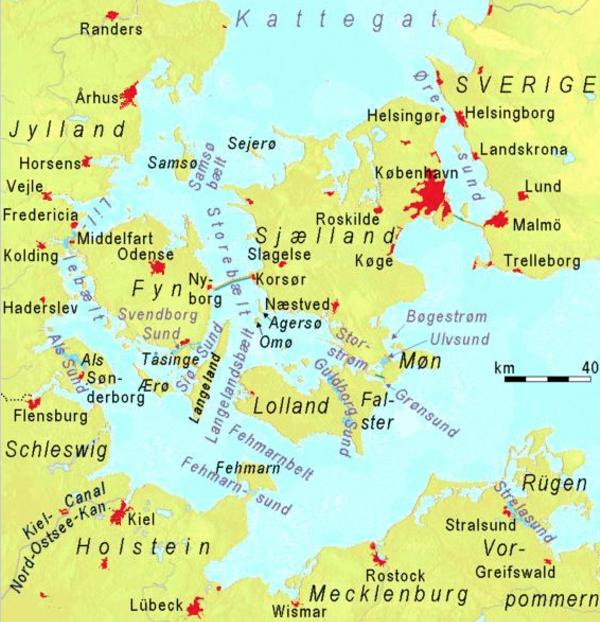
The chart of The Danish South Sea has the Danish mainland (Jylland) to the west and Sweden (Sverige) to the east. Mowa's Summer of 2016 voyage started from her home port of Lübeck. After overnight stops on Fehmarn and Haderslev Fjord, she headed north-west up the Lillebælt, one of three straits that allow passage between the Baltic and the shallow seas of the Kattegat. She explored anchorages around Middlefart before heading north to Århus. After a diversion west to Samsø, Mowa explored anchorages in the bay in the hook of land north-east of Århus.
Memories of Memory
~ The War Years ~
John Titchmarsh
Owner of Titchmarch Marina, Walton-on-the-Naze
Memory spent her war years 1939-1945 berthed in the salt-marshes at Walton-on-the-Naze in Essex: Arthur Ransom's sailing ground in Nancy Blackett. The marshes belong to the Frinton & Walton Yacht Trust and are home to the small boatyard of Bedwell & Co. Mr Bedwell is now deceased.
I became involved with Memory in 1941 at the age of 7 or 8 whilst trying to sail my little boat in one of the saltmarsh pools. A man with striking blond hair showed an interest in my efforts. The man was Mr Jimmy Cooper who lived in a nearby converted wooden lighter, built up to form a houseboat, number 534. Many years passed before I was to learn the significance of this number†.
Jimmy Cooper bought Memory as she lay in the saltmarsh with rot in three planks on her port quarter, the shear strake and two planks below that. Being worried about the condition of the yacht he sought the services of Mr Bert Wright, a shipwright who lived in the village of Kirby-le-Soken, who was working in Wivenhoe shipyard repairing and building minesweepers for the Admiralty. Mr Bert Wright was able to supply the small amount of the seasoned timber required and the work was carried out at Bedwell's yard. By this time the war years were coming to a close and Mr Cooper's thoughts were of sailing. Memory was then towed to a deeper, more useable berth where the cockpit was rebuilt.
I recall Memory being towed with a dinghy to the yacht club quay for fitting out and to await her first sail after her long refit. Memory had no engine, a primus paraffin stove in gimbals, oil lamps and no toilet with a wonderful smell of paraffin, hemp rope and paint.
Having been told that Jimmy intended to take this first sail alone I went along on the great day to wave Memory off on a short trip to her Twizzle Creek mooring. I must however have looked very sad because he invited me onboard and took me along, something I have never forgotten. At that time she was bermudan rigged with main and foresail brown tanned sails, with I believe an early form of roller foresail. He used to enthuse about not having the weight aloft and the complications associated with rigging and reefing an inferior gaff rig. We spent many happy hours just messing about in boats and he teaching me to sail. Jimmy was always so proud to be the owner of a Harrison Butler designed yacht. He stayed with my parents for some three years after the war and then moved to Roehampton where he was engaged in designing artificial limbs. We then lost touch with him. Many years later he turned up at our marina in Walton-on-the-Naze and borrowed a dinghy from us to visit old haunts. It was good to see him again and we enjoyed reminiscing. He sadly passed away not long after that.
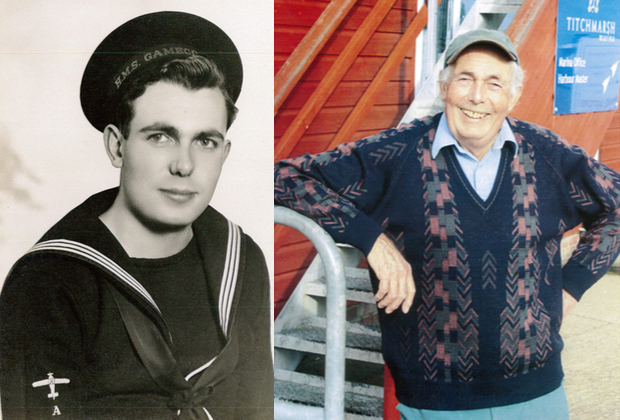
John Titchmarch as a younger man in the Royal Navy
and today, outside the office at Titchmarsh Marina.
John was born in 1934.
† 534 was the yard build number for the Queen Mary.
Ganga Devi - Part IV
~ The Red Sea ~
JOC Alexander
The Red Sea is a major challenge for a boat as small as our Harrison Butler designed Ganga Devi, with her waterline length of only 18 feet. The prevailing wind at the northern end is from the north giving a dead beat to windward against short steep seas in narrow reef strewn waters. As we recuperated in Aden from our 2,500 mile crossing of the Indian Ocean our unease at sailing the length of the Red Sea grew, especially after meeting the crews of two much bigger yachts which had taken three months to complete our proposed Red Sea passage - this was time we could ill afford in terms of both further extended leave from work and additional pressure on dwindling financial reserves. Fortunately we met Major Overton. He was going to ship his yacht as 'cargo' to Port Said from Aden. We decided to join him on a free 'indulgence passage' on the Tank Landing Ship (LST 3525) Empire Guillemot, due to sail on 4th May 1961. This gave us a two month break from voyaging, during which time we worked, ate well, and lifted out Ganga Devi for antifouling. To our surprise, her bottom was covered in Goose barnacles and so our recent passage making must have been against considerable drag. A bowsprit was added to carry more sail in the light winds we expected in the Mediterranean, once we'd passed through the Suez Canal.
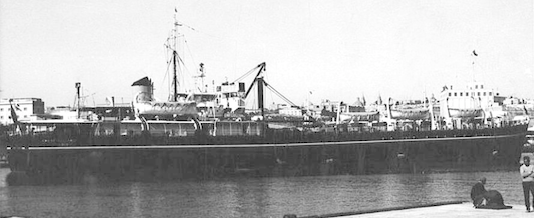
Empire Guillemot which carried Ganga Devi the length of the Red Sea.
The crane amidships was used to precariously off-load Ganga Devi at sea.
Following the Suez Crisis of 1956 which closed the Suez Canal from October 1956 until March 1957 and which ended in military humiliation for Britain and France, there was considerable political sensitivity over Ganga Devi's passage through the Canal; all three of her crew (myself, Hugh Burt and Adrian Corkill) were UK armed services personnel. Consequently the two yachts being transported as 'cargo' were off-loaded from the Empire Guillemot using her midships crane well to the south of Suez Bay. This clandestine activity took place in the dark at around 5 am on the morning of 10th May. It was a difficult operation and something of a miracle that neither the Major's nor our yacht was damaged. Stepping the two masts as the three vessels rolled in the swell all still tethered together was a total nightmare. Eventually we were ready to cast off from the Empire Guillemot and begin a beat north into Suez Bay. There we found a pleasant anchorage at the entrance to the canal on 11th May.
The Egyptian authorities insisted we appoint an agent, Stapledons, to arrange our transit at a cost of £90. A huge Egyptian policeman was put aboard and we were sternly forbidden to either go ashore anywhere or take photographs. In view of the fact that, as a Royal Signals Officer, I had been involved in the Anglo-French failed Suez military debacle I accepted the terms and conditions without argument.
For two days we were towed along the canal against a 4 knot current, behind two lighters pulled by a very smokey wood burning tug, the Newton Dunn. We anchored twice, in the Little Vitter Lake and Lake Timsah, to allow convoys to pass. Our tow ended at the Canal Company Yacht Club in Port Fouad. The Formalities to exit were as difficult as entry. They took a whole day before we were cleared to leave, in the dark, on 15 May. As we began our first sail across the waters of the Mediterranean, bound for Malta 900 miles away, our optimism that we might yet make it to England surged. Even having to don jerseys and oilies for the first time since the China Sea did not dent our high spirits. We were on the home straight.
To be continued...
.png)
Ganga Devi on passage through the Suez Canal, May 1961
Ghost Boat
~ Omega Of Vancouver ~
Paul Avery
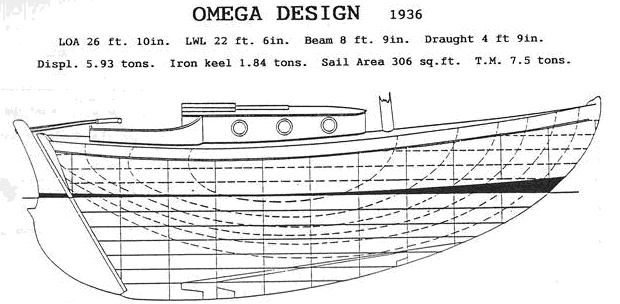
I noticed on the website that the Association is seeking information on Omega of Vancouver. I suspect I'm the person sought as I purchased a set of plans for the Omega design in 1983 and was set on building within a few years. I was living at the time on a small island off of Vancouver Island and had ambitious ideals. I started lofting the boat but that was as far as the project got. Instead of building the boat, I moved, got married, and had a family. Put simply, my life changed direction, but for the better !
I traveled to England in 1984 and met with the then HBA President, Joan Jardine-Brown, and traveled with her to view one of these designs, Jaslia, in the south of the country. I also met and stayed with Bob and Manette Van Hooghtien, past custodians of Omega of Broom, in Antwerp Belgium. I had been corresponding with them prior to traveling there.
I still have the plans, look at them occasionally, and still dream of building Omega of Vancouver as I remain convinced that the Omega design will yield the perfect small boat. I now have the ideal location in which to build her too; I'm just waiting for a shipload of cash to arrive and then I'll get started !
How To Obtain The Boat Plans of A Harrison Butler Design
Professionally digitised high resolution scans of Harrison Butler's boat designs are now available from HBA Chairman, John-Henry Bowden. The files are too big to attach to an email and are supplied by post on Memory Stick. These blueprints are suitable for building a full sized boat and cost £20 each for members, £30 for non-members. Any given design typically has two or three blueprints associated with it. Email John-Henry for further detail.

Waverly Shipbrush
Pertaining to Yachts and Yachting is a stunning oil on canvas in the cubist style, painted by Charles Scheeler in 1922. It's an example of an American art movement known as Precisionism in which the artist strives to reduce a composition to the brink of abstraction, retaining only the details necessary to preserve the intelligibility of the subject. The original painting is with the Philadelphia Museum of Art. Charles Scheeler didn't specialise in nautical art, this being one of only six or so explorations by him of 1920s yachting.
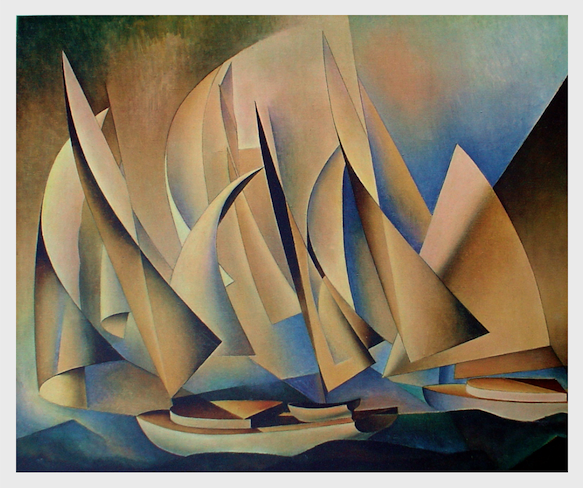
Pertaining to Yachts and Yachting by Charles Scheeler, 1922
Boat Spotted : Bolduster
Michiel Scholtes
The HBA's Netherlands Correspondent
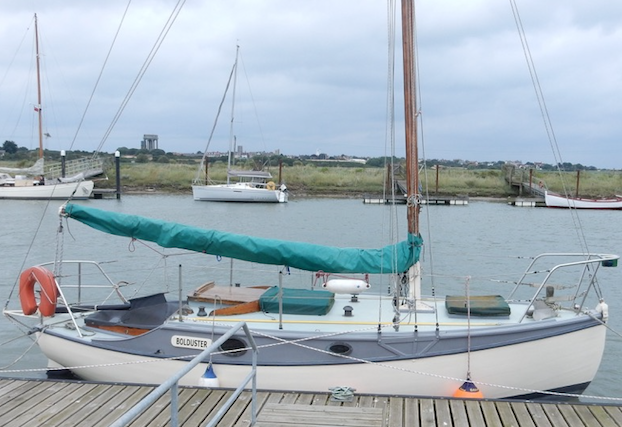
I spent the summer of 2016 sailing and hiding in the UK's East coast rivers. In Southwold I photographed an old acquaintance of the HBA: Bolduster, the Z4 with raised bulwarks stationed at Blyth. She was on the hard for general maintenance and at her pontoon when I passed again homebound a few weeks later.

HB = Harrison Butler Designed
AS = Albert Strange Designed
IF = Invited Friend - The link will give designer detail
Caracole : HB Bogle Design : 1934 : Portsmouth,UK : £15,000
Cyclone : HB Cyclone Design : 1941 : Netherlands : £12,600
Isabella : HB Omega Design : 1984 : Australia : £15,300
Jacaranda : HB Z4 : 1938 : Frankfurt, Germany : £2,800
Jane : HB Bogle Design : 1939 : Cornwall, UK : £10,000
Jolanda : HB Omega Design : 1996 : Germany : £29,400
Kelana : HB Z4 : 1939, Brighton UK : £300
La Bonne : HB Nursery Class : 1919 : Devon, UK : £POA
Little Kingfisher : HB Cyclone Design : Solent, UK : £12,500
Mary Gray : HB Zyklon Z4 Design : 1939 : Solent, UK : £7,500
Saltwind : HB Z4 : 1940 : Spain : £19,900
Sea Harmony : AS : 1937 : Massachusetts, USA : £25,000
Senorita : HB Cyclone II Design : 1934 : New Zealand : £4,000
Tamaroa : HB Thuella Design : 1973 : £9,000
Tally Ho : AS : 1909 : West Coast, USA : £25,000
Thule : HB Yonne Design : 1934 : Netherlands : £17,700 -£22,200
Watermaiden : HB Rose of Arden : 1939 : Cornwall : £15,950
Witte Walvis : HB Z4 : 1939 : Netherlands : £5,000
Zebedee : HB Z4 : 1938 : Ireland : £4,750
Zephon : HB Z4 : 1950 : Shetland, UK : £4,500
Zircon : HB Z4 : 1938 : River Orwell, UK : £5,000
Z4 Devalued
Lee Shore
The late Theo Rye's otherwise excellent two page article on the Z4 in Classic Boat, May 2016, made a comparison between the Z4 and what was, to me, an unknown car, the Austin 7. Charles Jackson took exception to the comparison and wrote in to the magazine to, in the nicest possible way, complain.
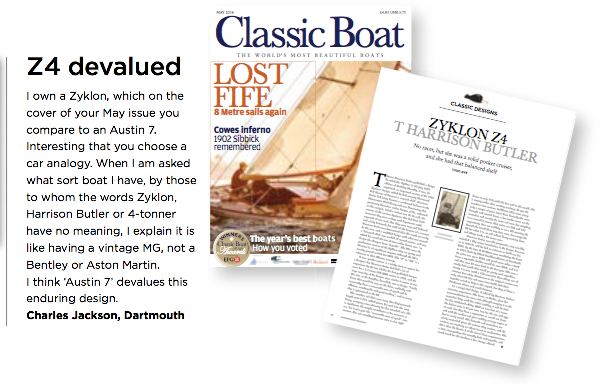
From the letters page of Classic Boat,
following the May 2016 article on the Z4
The letter prompted me think deeper about the wisdom of using a car analogy at all. Given that most readers of a sailing magazine probably know far more about boats than cars, the endeavour to explain one by likening it to the other is fundamentally flawed. There is an effort involved, all-be-it a small one, in asking Google to search “Austin 7”. Doing so brings up many similar images, a typical result being the attached photograph. It's a cute looking machine, but the fact that it was not what I was expecting, confirmed to me why the comparison doesn't work. To describe something that is to most people obscure (the Z4), with something else obscure (the Austin 7), is not going to be illuminating.
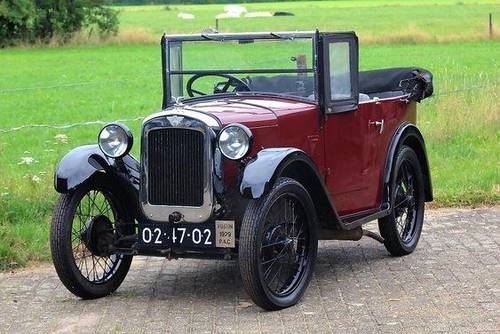

| | |